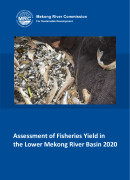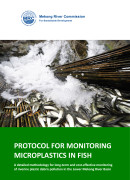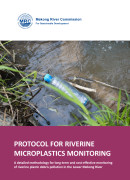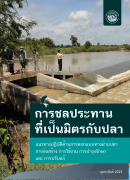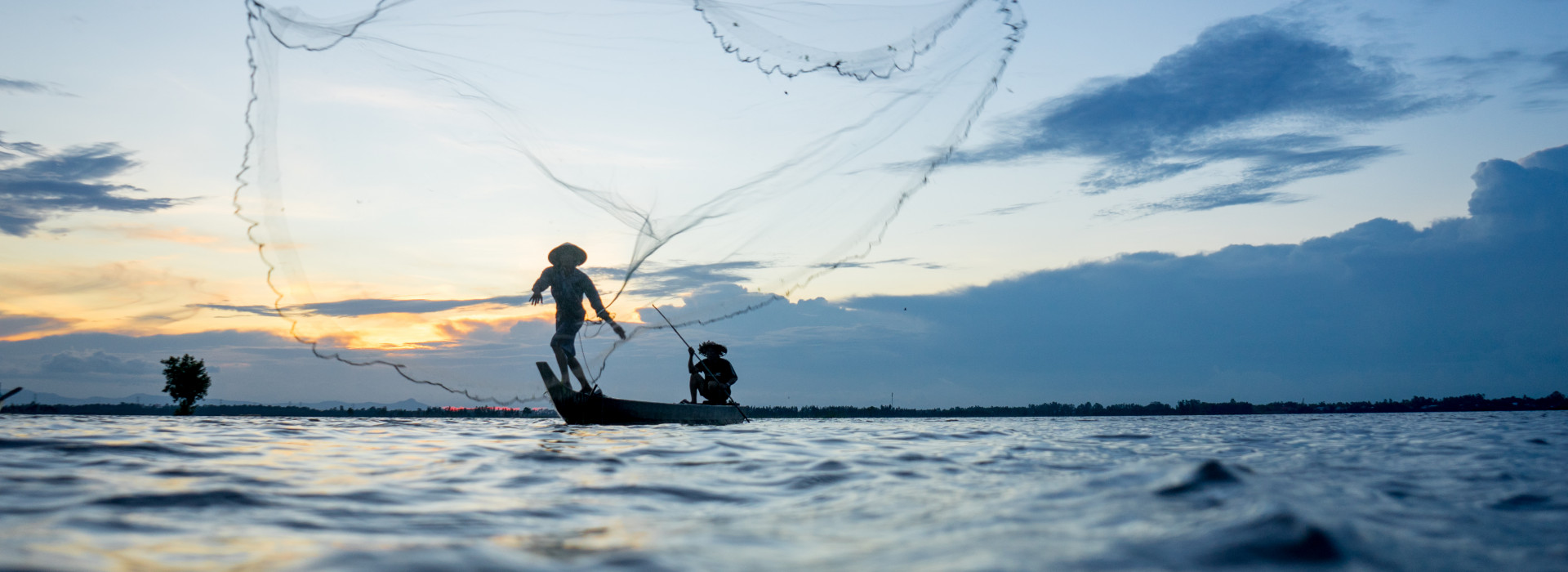
Fisheries
The Mekong River provides water, food and energy security for a population of about 70 million people, for most of whom the staple diet is rice, fish, and other aquatic animals. It is the world’s third most diverse fish population, with 1,148 fish species, after the Amazon and Congo river basins. The inland captured fisheries of the Lower Mekong River Basin (LMB) is the world largest, with the total fish catch estimated at 2.3 million tonnes and 11 billion US dollars per year.
The LMB’s fisheries therefore is of particular significance for millions of people depending on for food security and household income . With its increasing visibility, the Mekong fisheries also contributes to the social and economic growth and development in the basin.
Despite their importance, the Mekong fisheries is increasingly under pressure from a wide array of impacts from basin development and climate change. Such impacts, many of them negative, stem from the construction of hydropower dams, expansion of irrigated agriculture, flood control and protection infrastructure, and other water resources development projects.
Although the total fish catch appears to be increased over the past 15 years according to the State of the Basin Report 2018, signs of over-fishing with CPUE declining and fish size getting smaller are detected. According to the macroeconomic assessment report of the MRC Council Study, the net preserve value (NPV) of the fisheries sector is expected to decline by 16.5 million by 2020 and 22.6 million by 2040 in all lower Mekong countries: Cambodia, Lao PDR, Thailand and Viet Nam.
As the population of the LMB is predicted to grow to over 100 million by 2025, dependence on the fisheries sector will increase. If productivity declines, or if fisheries products are contaminated with industrial waste as observed in many other parts of the world, the consequences could be severe.
To address the current and emerging fisheries management issues, riparian governments have focused their policy priorities on improving productive capacities; protection and conservation of critical habitats and resource enhancement; modernisation of the traditional systems of extensive resource use and their equipment and techniques; fostering of community-based approaches; and promotion of the shift from subsistence to commercial production by professional fishers and fish farmers producing for the market.
To complement the national measures, the MRC strives to foster regional efforts towards sustainable management and development of the Mekong fisheries, including through sharing of technical know-how on fisheries management, raising awareness on the sector’s significance for the Mekong’s environment and its people, and promoting an integrated approach with other sectors. The MRC supports its Member Countries through:
- Basin-wide strategies such as the Mekong Basin-wide Fisheries Management and Development Strategy (BFMS) 2018-2022 that promotes dialogue, understanding, and learning to foster sustainable management and development of fisheries and aquatic resources in the LMB.
- Monitoring programmes to track the status and trends of fisheries and deploy different methods.
- Technical guidelines such as the co-fisheries management guidelines that seeks to promote participatory fisheries management or co-management by members of fisheries agencies and user communities, leading to better management results and sustainable use of fisheries resources.
- Studies and assessments that increase knowledge and evidences for better management of fisheries.
The fisheries sector is one of the MRC’s key water related sectors of support and coordination. Since the 1990s, the MRC has been a major source of information on Mekong inland fisheries. A series of projects started in 1994 to address the impacts of dams on migratory fish and mitigating measures, such as reservoir fisheries and aquaculture development. In 2000, fisheries projects were transformed into a comprehensive sector programme.
Phase 1 of the programme, which ran from 2001-2005, worked to raise awareness on the size, nature, and condition of LMB fisheries, and developed the capacity of national agencies and the MRC regarding sustainable management. From 2006-2010, the second phase placed an emphasis on formulating, promoting, and facilitating the implementation of a basin-wide strategy for the preservation and development of Mekong fish resources.
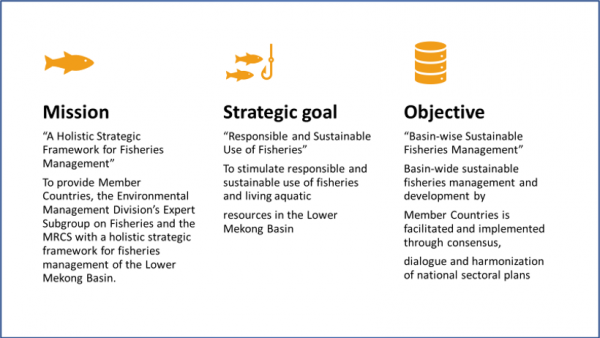
Figure 1 The mission, strategic goal and objective of the BFMS
Fisheries management requires more than national action. It necessitates a regional approach for sustainable management, utilisation, and development as many Mekong fish species are migratory, and some cross-national boundaries when moving from nursing and feeding to spawning grounds over their life cycle.
The MRC Fisheries Programme 2011-2015 was developed within the scope, guidance, and framework provided by the 1995 Mekong Agreement. It was linked with the MRC vision of sustainable development, to its contribution to achievement of the Millennium Development Goals, and to the decision by the MRC Member Countries to use IWRM as its basic approach to basin planning and management.
The programme addressed the sustainable management and development of fisheries for poverty alleviation by focusing on three strategies: delivering knowledge and fostering understanding of the key issues affecting fisheries in the region; contributing to improved policies and institutions for better fisheries management and development; and improving fisheries management skills and capacity in government agencies and fisher communities.
It fostered regional dialogue and the exchange of information and experience by diverse fisheries stakeholders through regular events, such as advisory meetings and technical symposia, which promote the use of scientific fisheries information in making well-founded decisions and implementing realistic plans. It fostered the ability of government agencies to support user communities in fisheries management activities, and also established fisher groups and organisations that were trained to plan and implement sustainable fisheries management.
For more than a decade, the MRC’s support in the fisheries sector campaigned for the acceptance of the importance of Mekong fisheries by governments and the people. It succeeded in having fisheries concerns taken up in national and regional policies on agriculture, nutrition, and natural resource management. This is a major turnaround from the early 2000s, when fisheries were generally downplayed in development planning.
Following the completion of the Fisheries Programme, the Mekong Basin-wide Fisheries Management and Development Strategy (BFMS) 2018-2022 was developed on the basis of the Integrated Water Resources Management-based Basin Development Strategy (BDS) 2016-2020 in close collaboration with the MRC Member Countries.
Figure 1 details the strategy’s mission, goal and objective.
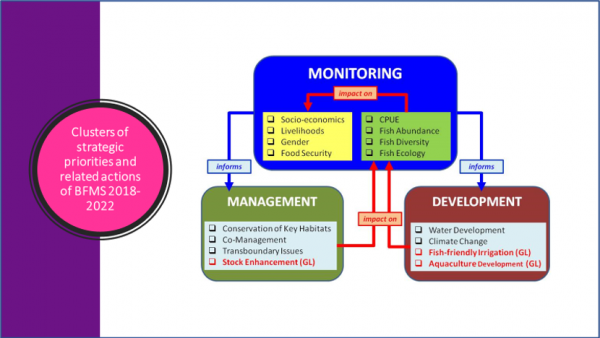
Figure 2 The three clusters of the BFMS
Focusing on inland fisheries, the BFMS 2018-2022 encompasses ten key strategic priorities and related actions, which are categorised in three clusters (Figure 2). It encourages dialogue, understanding, and learning to foster sustainable management and development of fisheries and aquatic resources in the LMB. The implementation of this strategy is envisaged to follow a Project Based Action Plan (PBAP), which was finalised in October 2019. The PBAP is complementary of other relevant regional and national action plans and its outcomes were reflected in the Strategic Plan (SP) 2021-2025. It will be reviewed and updated every five years and expanded to include additional key regional and transboundary fisheries management issues identified in the updated BFMS to further promote sustainable fisheries resources within basin.
Under the BDS 2021-2030 and MRC Strategic Plan (SP) 2021-2025, the MRC utilises its fisheries expertise to support the Member Countries via its regional Expert Group on Environmental Management in managing risks to food security from excessive pressure on fish stocks and in improving understanding of the gender and vulnerability aspects of basin-wide fisheries management. In addition, the MRC coordinates the implementation of the BFMS and facilitates the identification and implementation of associated measures in fisheries management.
In order to ensure long-term sustainability of the LMB’s fisheries and achieve the strategic goals of poverty reduction and economic development, the MRC has conducted assessments and studies to increase knowledge and evidences for better management of fisheries. Some recent studies are highlighted below:
- Updated fisheries database: Published in 2019, the updated database provides comprehensive information on fishes in the Mekong Basin including the Sekong, Sesan and Srepok Rivers and the Tonle Sap River.
- The State of the Basin Report (SOBR): Published in 2019, the SOBR provides an overall picture of the Mekong River Basin in terms of its ecological health and the social and economic circumstances of its people, and the degree to which the cooperation between riparian countries envisaged under the 1995 Mekong Agreement is enhancing these conditions.
- The Council Study: Published in 2017, the Council Study aims to improve understanding of the impact of different water-related development opportunities within the whole Mekong River Basin, and provides transboundary and cumulative impact assessment, including on fish and fisheries in the LMB.
- Review of existing research on fish passage through large dams and its applicability to Mekong mainstream dams: Published in 2015, the study summarises current knowledge on fish-pass solutions for both upstream and downstream migration. It provides guidance to practitioners on the current state of fish passage through large dams, highlights knowledge gaps in design and operation of fish passes, and proposes further research required to fill these gaps.
- Mitigation of the impacts of dams on fisheries - a primer: While dams bring benefits, the 2017’s study highlights possible negative impacts of dams on fisheries, and approaches to mitigate such impacts. It introduces the concepts of offsets or compensation for impact, and enhancement and intensification of reservoir fisheries, positive outcomes from many dam projects.
- Fisheries research and development in the Mekong region (Catch and Culture, Volume 21, No.3): Published in 2015, the research estimates the lower Mekong fisheries at $17 billion a year, based on total production of 4.4 million tonnes for both capture fisheries and aquaculture within the basin.
To support implementation of the BFMS, the MRC, under its Strategic Plan 2016-2020, has developed the following guidelines, strategies, and action plans for inland fisheries development and management in the LMB.
- Guidelines for good aquaculture development practices: to prevent environmental degradation and pollution from practices in aquaculture system and promote knowledge sharing on fish culture techniques including Mekong indigenous species.
- Guidelines for fisheries co-management at local/sub-basin levels in the LMB: to strengthen cooperation between fishers, their organisations and governments to manage fisheries according to the legal and regulatory frameworks for resource use. The guideline also aims to promote collaboration among at least two Member Countries in the LMB for transboundary fisheries management.
- An action plan for implementation of the guidelines for better stock enhancement in the LMB: to promote fish stock enhancement to secure well-being of ecological system of fish habitats including secured ecological health along transboundary areas in the LMB.
- An action plan for implementation of a code of practice for transboundary movement of aquatic organisms: to prevent pathogen and disease from transporting aquatic organisms from one country to other country.
- Technical guidance for transboundary fisheries management in the Lower Mekong River Basin: The guidance is an applicable tool to implement and establish joint platforms for transboundary fisheries management at national and regional levels. It will be introduced and applied for new and existing fisheries resources management and conservation projects in the four Member Countries.
- Guidelines for fish friendly irrigation schemes: In 2014, the MRC developed the guidelines on ‘Prioritizing Fish Passage Barriers and Creating Fish-Friendly Irrigation Structures’ based on a literature review and international experience. The guidelines outline methods for identifying barriers to fish migration, and the processes for the design, construction and maintenance of fish passages. The MRC, in collaboration with the U.S. Department of the Interior (DOI) and the Australian Center for International Agricultural Research (ACIAR), is now testing the guidelines to assess their effectiveness and identify areas for improvement. Inputs will be used to revise the guidelines and develop an action plan for promoting fish passage installation in the LMB.
Recognising the need to maintain fisheries and aquatic resources in light of development pressures in the basin, the MRC and Member Countries have prioritised fisheries monitoring in order to understand current and emerging trends.
The MRC fisheries monitoring consists of three types: Dai fishery, fish larvae drift monitoring (FLDM) and fish abundance and diversity monitoring (FADM). The monitoring measures yield indicators contributing to the interpretation of the status and trends of basin-wide capture fisheries and provides effective means to assess the effects of development activities on water resources in the basin.
Building on the longstanding monitoring of the river’s resources and conditions, the MRC and Member Countries in February 2020 launched the Joint Environmental Monitoring (JEM) Programme. The JEM aims to systematically collect, generate and share reliable and scientific data and information through a standardised basin wide joint environmental monitoring programme on site-specific issues that have cross-national implications. Fisheries is one of the five key disciplines of the JEM Programme, together with hydrology, sediment, water quality, and ecological health.
Click here for more information on the MRC’s fisheries monitoring work.
The MRC has produced a series of knowledge products, including strategies, guidelines and studies mentioned above, to facilitate decision-making and stimulate innovations for sustainable management of the fisheries sector.
- Catch and Culture Newsletter: The MRC Secretariat publishes the newsletter three times a year to provide up-to-date information and knowledge on fish, fisheries, aquaculture and environment in the Mekong River Basin. The newsletter is distributed to more than 650 subscribers around the world.
